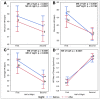Full-Body Photobiomodulation Therapy Is Associated with Reduced Sleep Durations and Augmented Cardiorespiratory Indicators of Recovery
- PMID: 36006085
- PMCID: PMC9414854
- DOI: 10.3390/sports10080119
Full-Body Photobiomodulation Therapy Is Associated with Reduced Sleep Durations and Augmented Cardiorespiratory Indicators of Recovery
Abstract
Research is emerging on the use of Photobiomodulation therapy (PBMT) and its potential for augmenting human performance, however, relatively little research exists utilizing full-body administration methods. As such, further research supporting the efficacy of whole-body applications of PBMT for behavioral and physiological modifications in applicable, real-world settings are warranted. The purpose of this analysis was to observe cardiorespiratory and sleep patterns surrounding the use of full-body PBMT in an elite cohort of female soccer players. Members of a women's soccer team in a "Power 5 conference" of the National Collegiate Athletic Association (NCAA) were observed across one competitive season while wearing an OURA Ring nightly and a global positioning system (GPS) sensor during training. Within-subject comparisons of cardiorespiratory physiology, sleep duration, and sleep composition were evaluated the night before and after PBMT sessions completed as a standard of care for team recovery. Compared to pre-intervention, mean heart rate (HR) was significantly lower the night after a PBMT session (p = 0.0055). Sleep durations were also reduced following PBMT, with total sleep time (TST) averaging 40 min less the night after a session (p = 0.0006), as well as significant reductions in light sleep (p = 0.0307) and rapid eye movement (REM) sleep durations (p = 0.0019). Sleep durations were still lower following PBMT, even when controlling for daily and accumulated training loads. Enhanced cardiorespiratory indicators of recovery following PBMT, despite significant reductions in sleep duration, suggest that it may be an effective modality for maintaining adequate recovery from the high stress loads experienced by elite athletes.
Keywords: athlete monitoring; exercise training; red light therapy; soccer; wearable device.
Conflict of interest statement
The authors declare no conflict of interest.
Figures




Similar articles
-
Infrared Low-Level Laser Therapy (Photobiomodulation Therapy) before Intense Progressive Running Test of High-Level Soccer Players: Effects on Functional, Muscle Damage, Inflammatory, and Oxidative Stress Markers-A Randomized Controlled Trial.Oxid Med Cell Longev. 2019 Nov 16;2019:6239058. doi: 10.1155/2019/6239058. eCollection 2019. Oxid Med Cell Longev. 2019. PMID: 31827687 Free PMC article. Clinical Trial.
-
Factors Associated With Noncontact Injury in Collegiate Soccer: A 12-Team Prospective Study of NCAA Division I Men's and Women's Soccer.Am J Sports Med. 2021 Sep;49(11):3076-3087. doi: 10.1177/03635465211036447. Epub 2021 Aug 18. Am J Sports Med. 2021. PMID: 34406087
-
Acute Photobiomodulation Does Not Influence Specific High-Intensity and Intermittent Performance in Female Futsal Players.Int J Environ Res Public Health. 2020 Oct 4;17(19):7253. doi: 10.3390/ijerph17197253. Int J Environ Res Public Health. 2020. PMID: 33020394 Free PMC article. Clinical Trial.
-
The Effectiveness of Photobiomodulation Therapy Versus Cryotherapy for Skeletal Muscle Recovery: A Critically Appraised Topic.J Sport Rehabil. 2019 Jul 1;28(5):526-531. doi: 10.1123/jsr.2017-0359. Epub 2019 Jan 29. J Sport Rehabil. 2019. PMID: 29952693 Review.
-
Stress, Sleep and Recovery in Elite Soccer: A Critical Review of the Literature.Sports Med. 2015 Oct;45(10):1387-400. doi: 10.1007/s40279-015-0358-z. Sports Med. 2015. PMID: 26206724 Review.
Cited by
-
Traumatic brain injury and sleep in military and veteran populations: A literature review.NeuroRehabilitation. 2024;55(3):245-270. doi: 10.3233/NRE-230380. NeuroRehabilitation. 2024. PMID: 39121144 Free PMC article. Review.
-
Whole-Body Photobiomodulation Therapy for Fibromyalgia: A Feasibility Trial.Behav Sci (Basel). 2023 Aug 29;13(9):717. doi: 10.3390/bs13090717. Behav Sci (Basel). 2023. PMID: 37753995 Free PMC article.
-
Vascular Responses following Light Therapy: A Pilot Study with Healthy Volunteers.J Clin Med. 2023 Mar 13;12(6):2229. doi: 10.3390/jcm12062229. J Clin Med. 2023. PMID: 36983231 Free PMC article.
References
-
- Humphreys B., Ruseski J. The Size and Scope of the Sports Industry in the United States; Proceedings of the 10th Annual International Association of Sports Economists Conference; Gijón, Spain. 29–31 August 2008.
-
- Dos Santos M.L., Uftring M., Stahl C.A., Lockie R.G., Alvar B., Mann J.B., Dawes J.J. Stress in Academic and Athletic Performance in Collegiate Athletes: A Narrative Review of Sources and Monitoring Strategies. Front. Sports Act. Living. 2020;2:42. doi: 10.3389/fspor.2020.00042. - DOI - PMC - PubMed
LinkOut - more resources
Full Text Sources
Research Materials

